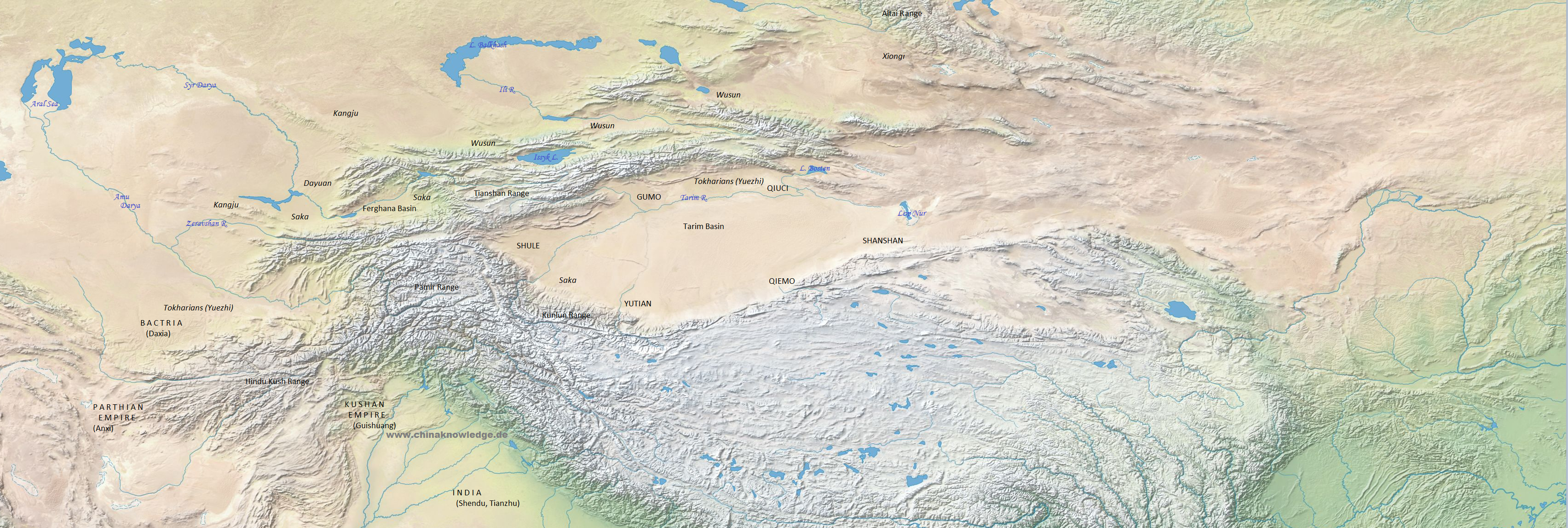Tokhara or Tukhara, Chinese transcription Tuhuoluo 吐火羅, also called Tokharistan, is a region and a kingdom (or rather, several kingdoms in succession) located in the triangle between the Pamir and the Hindukush Ranges and the River Amu Darya the south of modern Uzbekistan and the north of Afghanistan. The name Tuhuluo 吐呼羅 is first mentioned in the official dynastic history Weishu 魏書. The name is transcribed as Tuhuoluo during the Tang period and appears as Tuhuoluo 土豁羅 in the Xintangshu 新唐書. The Buddhist sutra Za ahan jing 雜阿含經 writes Doushaluo 兜沙羅, the biographic collection Gaosengzhuan 高僧傳 Douquluo 兜佉羅 or Duhuoluo 覩貨羅, the geography Da-Tang xiyu ji 大唐西域記 Duhuoluo 覩貨邏.
 |
Based on Tan Qixiang 譚其驤, ed. (1995), Zhongguo lishi ditu ji 中國歷史地圖集, Vol. 2, Qin, Xihan, Donghan shiqi 秦西漢東漢時期 (Beijing: Zhongguo ditu chubanshe, 1996). Tribes and peoples in italics, states in normal letters. |
During the Han period 漢 (206 BCE-220 CE) the region was called Daxia 大夏 (Bactria) and was visited by the traveller Zhang Qian 張騫. Before the Chinese explored the region the country was reigned by the Hellenic dynasty of the Seleucids and the dynasty of the Arsacids in Bactria (northern Afghanistan), but during the Han period the kingdom was already destroyed by the Yuezhi 月氏 (the proper Tokharians) that founded the kingdom of Kushana (Chinese name Guishuang 貴霜).
During the 6th century the kingdom of Kushana was controlled by the Hephthalites (Chinese name Yeda 嚈噠). In the following centuries there were again intensive relations with the Chinese empire of the Tang 唐 (618-907) that expanded its protectorate (duhufu 都護府) far into Central Asia. The Tang took over control over the region and founded several area commands (dudufu 都督府) with indirectly administered prefectures (jimizhou 羈縻州). At that time the population of the region was mixed of Tokharians, Persians from the Sassanid empire and Türks.
For all important states Asia the region of Tokharistan was a crossroads between east and west and towards the south to India. Not only merchants travelled these ways, but also a lot of Chinese monks like Xuanzang 玄奘 who described all countries he had visited in his Da-Tang xiyu ji. During the early 7th century there were a lot of statelets scattered over Tokharistan, a circumstance that made it easier for the Tang emperors to bestow the local rulers the titles of commander-in-chief (dudu 都督) of the Tang empire. Emperor Gaozong 唐高宗 (r. 649-683), for instance, created the area command of the Yuezhi 月氏都督府 and bestowed its commander the title of yabghu (a Türkic sub-khan) of Tokharistan, King of the Hephthalites and military commissioner of 25 prefectures. In the mid of the 8th century the Arabs arrived in Central Asia and destroyed the ancient polities in that region. The name Tokhara disappears in Chinese sources in the 13th century.
There is still much discussion about the ethnicity of the Tokharians, yet most scholars believe they were related to the Iranians.